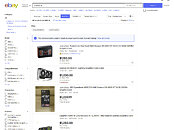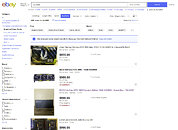- Joined
- May 14, 2004
- Messages
- 28,520 (3.73/day)
| Processor | Ryzen 7 5700X |
|---|---|
| Memory | 48 GB |
| Video Card(s) | RTX 4080 |
| Storage | 2x HDD RAID 1, 3x M.2 NVMe |
| Display(s) | 30" 2560x1600 + 19" 1280x1024 |
| Software | Windows 10 64-bit |
The major GPU releases in 2020 are all plagued by the same problem: good product, not enough stock. This has led to a perverse situation on the market: you can't just walk into your favorite store and purchase the product you want. This is a consequence of NVIDIA and AMD going to market with tiny volumes, and extremely optimistic MSRPs which opened up the market to the phenomenon of scalping. Scalpers are individuals, or groups, who buy up whatever little volume is available, often using sophisticated online shopping bots, and resell them at exorbitant premiums on marketplaces like eBay, for profit.
This system only works because there is zero retail stock available anywhere on the planet, and whatever volume comes in, is so low that it evaporates, often before hitting retailer shelves. The only way scalping can be defeated is for manufacturers to flood the market with large volumes of product that the scalpers cannot scale their purchases up to, and possibly for crypto-currency mining to become not worth it on the latest generations of graphics cards. Until these happen, marked-up pricing is an inescapable reality for consumers.


We believe that exposing readers to MSRP pricing alone in our graphics card reviews, would be doing them disservice. That's why I've decided to consider the pricing of the lowest valid eBay.com listing in my graphics card reviews, too, in cases where none are available on our main retail pricing source, Newegg.com. We do not condone the practice of scalping, but at the same time, it's just not right to report and discuss prices that you can't actually buy the product at.
How We Reported Graphics Card Prices in Our Reviews Until Now
If a price is available on Newegg for the tested product, use that. If not available, possibly because day-one review, for which no other source of information exists, use the MSRP. For the huge list of "reference" comparison cards in reviews, the cheapest Newegg price of the series is used. For older cards, which are no longer in production, the Newegg price can often be too high, because 3rd party sellers are trying to profit. In that case the last available reasonable price point is considered.
How We Intend to Report Pricing Now
I'll try to determine pricing by first looking it up on Newegg, and only use the Newegg price if the product is available (ready to purchase and ship) at the time of writing. For older products nothing changes. If a product is completely sold out on Newegg, like all GeForce RTX 30 and Radeon RX 6800/6900 Series currently, I will look it up on eBay, which is one of the leading marketplaces where people resell their graphics cards.
The search uses the following parameters:
For example, for a hypothetical RX 6700 XT, which is 15% slower than the RX 6800 non-XT (currently going for $850 on eBay, MSRP was $580), I would estimate $700 ($850, minus 15%, minus some premium for lower absolute performance). Obviously this isn't going to be 100% perfect, but I feel that will be more useful than simply parroting back "the MSRP is $400, super affordable, just buy it".
In the review's conclusion I will discuss MSRP, supply situation, the current market price and how that compares to other alternatives on the market. The Performance per Dollar charts will now have the price for calculation appended after the product name. When the MSRP is used, a pink bar with price/performance at MSRP gets added. Comparison cards (gray bars) will be shown at their street price only, MSRP won't be listed. The chart below should illustrate this sufficiently.

We welcome your comments and constructive feedback.
View at TechPowerUp Main Site
This system only works because there is zero retail stock available anywhere on the planet, and whatever volume comes in, is so low that it evaporates, often before hitting retailer shelves. The only way scalping can be defeated is for manufacturers to flood the market with large volumes of product that the scalpers cannot scale their purchases up to, and possibly for crypto-currency mining to become not worth it on the latest generations of graphics cards. Until these happen, marked-up pricing is an inescapable reality for consumers.


We believe that exposing readers to MSRP pricing alone in our graphics card reviews, would be doing them disservice. That's why I've decided to consider the pricing of the lowest valid eBay.com listing in my graphics card reviews, too, in cases where none are available on our main retail pricing source, Newegg.com. We do not condone the practice of scalping, but at the same time, it's just not right to report and discuss prices that you can't actually buy the product at.
How We Reported Graphics Card Prices in Our Reviews Until Now
If a price is available on Newegg for the tested product, use that. If not available, possibly because day-one review, for which no other source of information exists, use the MSRP. For the huge list of "reference" comparison cards in reviews, the cheapest Newegg price of the series is used. For older cards, which are no longer in production, the Newegg price can often be too high, because 3rd party sellers are trying to profit. In that case the last available reasonable price point is considered.
How We Intend to Report Pricing Now
I'll try to determine pricing by first looking it up on Newegg, and only use the Newegg price if the product is available (ready to purchase and ship) at the time of writing. For older products nothing changes. If a product is completely sold out on Newegg, like all GeForce RTX 30 and Radeon RX 6800/6900 Series currently, I will look it up on eBay, which is one of the leading marketplaces where people resell their graphics cards.
The search uses the following parameters:
- Brand new
- Ships to the USA
- Sort pricing by "lowest first" (price+shipping)
- Manually inspect and filter out individual listings that look "fake"
- The listing must be ready to purchase ("Buy it Now"), and must ship within 7 days of receipt of payment (ensures that the scalper physically possesses the merchandise they're trying to sell)
For example, for a hypothetical RX 6700 XT, which is 15% slower than the RX 6800 non-XT (currently going for $850 on eBay, MSRP was $580), I would estimate $700 ($850, minus 15%, minus some premium for lower absolute performance). Obviously this isn't going to be 100% perfect, but I feel that will be more useful than simply parroting back "the MSRP is $400, super affordable, just buy it".
In the review's conclusion I will discuss MSRP, supply situation, the current market price and how that compares to other alternatives on the market. The Performance per Dollar charts will now have the price for calculation appended after the product name. When the MSRP is used, a pink bar with price/performance at MSRP gets added. Comparison cards (gray bars) will be shown at their street price only, MSRP won't be listed. The chart below should illustrate this sufficiently.

We welcome your comments and constructive feedback.
View at TechPowerUp Main Site






